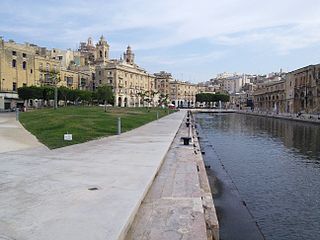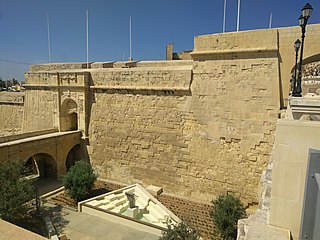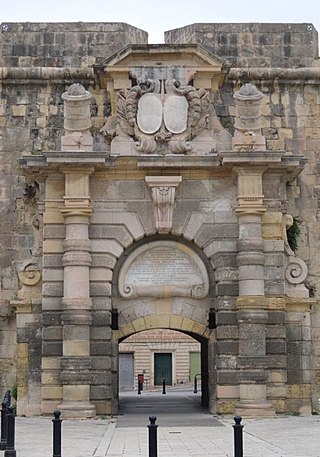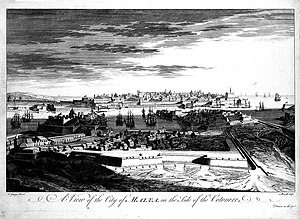
António Manoel de Vilhena was a Portuguese nobleman who was the 66th Prince and Grand Master of the Order of St. John of Jerusalem from 19 June 1722 to his death in 1736. Unlike a number of the other Grand Masters, he was benevolent and popular with the Maltese people. Vilhena is mostly remembered for the founding of Floriana, the construction of Fort Manoel and the Manoel Theatre, and the renovation of the city of Mdina.

Cospicua (Italian) or Bormla, occasionally also known by the Latin name Cottonera, is a double-fortified harbour city in the Port Region of Malta. As Maleth, it served as the principal port of Phoenician Malta and, through Greek, Latin, and Arabic, may have given its name to the island and country. Along with Birgu and Senglea, it is one of the Three Cities located within the Grand Harbour to the east of the capital city Valletta. With a population of 5,395 as of March 2014, it is the most dense city of the Three Cities. Locals are known for their Cottonera dialect.

Fort Ricasoli is a bastioned fort in Kalkara, Malta, which was built by the Order of Saint John between 1670 and 1698. The fort occupies a promontory known as Gallows' Point and the north shore of Rinella Bay, commanding the entrance to the Grand Harbour along with Fort Saint Elmo. It is the largest fort in Malta and has been on the tentative list of UNESCO World Heritage Sites since 1998, as part of the Knights' Fortifications around the Harbours of Malta.

Fort Saint Elmo is a star fort in Valletta, Malta. It stands on the seaward shore of the Sciberras Peninsula that divides Marsamxett Harbour from Grand Harbour, and commands the entrances to both harbours along with Fort Tigné and Fort Ricasoli. It is best known for its role in the Great Siege of Malta in 1565.
Charles François de Mondion was a French architect and military engineer who was active in Hospitaller Malta in the early 18th century. He was also a member of the Order of Saint John.

Fort St. Angelo is a bastioned fort in Birgu, Malta, located at the centre of the Grand Harbour. It was originally built in the medieval period as a castle called the Castrum Maris. It was rebuilt by the Order of Saint John as a bastioned fort called Fort Saint Angelo between the 1530s and the 1560s, and it is best known for its role as the Order's headquarters during the Great Siege of Malta of 1565. A major reconstruction to designs of Carlos de Grunenbergh took place in the 1690s, giving the fort its current appearance.
The Three Cities is a collective description of the three fortified cities of Vittoriosa, Senglea and Cospicua in Malta. The oldest of the Three Cities is Vittoriosa, which has existed since prior to the Middle Ages. The other two cities, Senglea and Cospicua, were both founded by the Order of Saint John in the 16th and 17th centuries. The Three Cities are enclosed by the Cottonera Lines, along with several other fortifications. The term Cottonera is synonymous with the Three Cities, although it is sometimes taken to also include the nearby town of Kalkara.

The Cottonera Lines, also known as the Valperga Lines, are a line of fortifications in Bormla and Birgu, Malta. They were built in the 17th and 18th centuries on higher ground and further outwards than the earlier line of fortifications, known as the Santa Margherita or Firenzuola lines, which also surround Bormla.

The Floriana Lines are a line of fortifications in Floriana, Malta, which surround the fortifications of Valletta and form the capital city's outer defences. Construction of the lines began in 1636 and they were named after the military engineer who designed them, Pietro Paolo Floriani. The Floriana Lines were modified throughout the course of the 17th and 18th centuries, and they saw use during the French blockade of 1798–1800. Today, the fortifications are still largely intact but rather dilapidated and in need of restoration.

The fortifications of Malta consist of a number of walled cities, citadels, forts, towers, batteries, redoubts, entrenchments and pillboxes. The fortifications were built over hundreds of years, from around 1450 BC to the mid-20th century, and they are a result of the Maltese islands' strategic position and natural harbours, which have made them very desirable for various powers.

Tal-Borg Battery was an artillery battery near Tarxien, Malta, built by Maltese insurgents during the French blockade of 1798–1800. It was part of a chain of batteries, redoubts and entrenchments encircling the French positions in Marsamxett and the Grand Harbour.

Fort San Salvatore, also known as Fort Salvatore, is a retrenched fort in Birgu, Malta. It was built in 1724 on one of the bastions of the Cottonera Lines. It was used as a prisoner-of-war camp during the Greek War of Independence and World War I, and as an internment camp and kerosene depot in World War II.

Fort Verdala, also known as Verdala Barracks, is a fortified barracks in Cospicua, Malta. It was built by the British in the 1850s within part of the bastions of the 17th century Santa Margherita Lines. The fort was used as a prisoner-of-war camp in both World Wars, and was later known as HMS Euroclydon. It remained in use by the British military until 1977.

The fortifications of Valletta are a series of defensive walls and other fortifications which surround Valletta, the capital city of Malta. The first fortification to be built was Fort Saint Elmo in 1552, but the fortifications of the city proper began to be built in 1566 when it was founded by Grand Master Jean de Valette. Modifications were made throughout the following centuries, with the last major addition being Fort Lascaris which was completed in 1856. Most of the fortifications remain largely intact today.

The fortifications of Mdina are a series of defensive walls which surround Mdina, the former capital city of Malta from antiquity to the medieval period. The city was founded as Maleth by the Phoenicians in around the 8th century BC, and it later became part of the Roman Empire under the name Melite. The ancient city was surrounded by walls, but very few remains of these have survived.

The fortifications of Birgu are a series of defensive walls and other fortifications which surround the city of Birgu, Malta. The first fortification to be built was Fort Saint Angelo in the Middle Ages, and the majority of the fortifications were built between the 16th and 18th centuries by the Order of Saint John. Most of the fortifications remain largely intact today.

The fortifications of Senglea are a series of defensive walls and other fortifications which surround the city of Senglea, Malta. The first fortification to be built was Fort Saint Michael in 1552, and the majority of the fortifications were built over the next decade when it was founded by Grand Master Claude de la Sengle. Modifications continued until the 18th century, but large parts of the fortifications were demolished between the 19th and 20th centuries. Today, all that remain of Senglea's fortifications are the seaward bastions and part of the land front.

St. Helen's Gate, also known as Porta dei Mortari, is the main gate of the Santa Margherita Lines, located in Cospicua, Malta. It was built in the Baroque style in 1736 to designs of Charles François de Mondion, during the magistracy of Grand Master António Manoel de Vilhena.

The Notre Dame Gate, also known as the Notre Dame de la Grace Gate, the Cottonera Gate, the Żabbar Gate or Bieb is-Sultan, is the main gate of the Cottonera Lines, located in Cottonera, Malta. The gate was built in 1675 in the Baroque style, and it is currently used as the headquarters of the heritage organization Fondazzjoni Wirt Artna.

On 18 July 1806, approximately 40,000 lb (18,000 kg) of gunpowder stored in a magazine (polverista) in Birgu, Malta, mistakenly detonated. The explosion killed an estimated 200 people, including British and Maltese military personnel, and Maltese civilians from Birgu. Parts of the city's fortifications, some naval stores, and many houses were destroyed. The accident was found to be the result of negligence while transferring shells from the magazine.




















